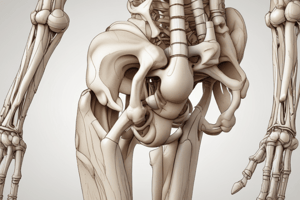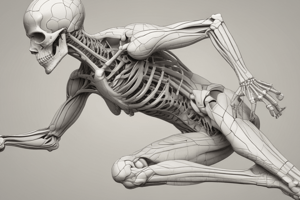Podcast
Questions and Answers
What is the structural classification of the temporomandibular joint?
What is the structural classification of the temporomandibular joint?
- Cartilaginous
- Fibrous
- Synovial (correct)
- None of the above
Which joint type is the atlanto-axial joint?
Which joint type is the atlanto-axial joint?
- Hinge
- Condyloid
- Pivot (correct)
- Ball and socket
Which of the following joints is classified as a ball and socket joint?
Which of the following joints is classified as a ball and socket joint?
- Atlanto-occipital joint
- Elbow joint
- Hip joint (correct)
- Knee joint
What is the relationship between joint stability and range of motion?
What is the relationship between joint stability and range of motion?
What are the three functional classifications of joints?
What are the three functional classifications of joints?
What are the six types of synovial joints?
What are the six types of synovial joints?
What are the functions of synovial fluid?
What are the functions of synovial fluid?
What is a joint?
What is a joint?
What are tendon sheaths?
What are tendon sheaths?
What is bursae?
What is bursae?
Why do women have a higher risk of ACL injury than men?
Why do women have a higher risk of ACL injury than men?
What is the 'unhappy triad'?
What is the 'unhappy triad'?
Flashcards are hidden until you start studying
Study Notes
Joints Overview
- Flat bones of the skull are joined by fibrous joints at the coronal suture, classifying structurally as fibrous and functionally as synarthrosis.
- The temporomandibular joint is a synovial joint with diarthrosis function, allowing elevation, flexion, protraction, retraction, and gliding movements.
- The atlanto-occipital joint is a synovial, diarthrosis joint of condyloid type, facilitating flexion, extension, and gliding.
- The atlanto-axial joint, a pivot type of synovial joint, permits rotation movements.
- Vertebral column joints are classified as cartilaginous (symphysis) and functionally categorized as amphiarthrosis.
- Intervertebral joints are synovial and diarthrosis, allowing for flexion, extension, and rotation.
- The sacroiliac joint is a synovial, diarthrosis joint, permitting slight gliding movements.
- The pubic symphysis is a cartilaginous symphysis joint, functioning as amphiarthrosis.
Major Joints
- The glenohumeral joint is a ball-and-socket synovial joint with diarthrosis function, allowing extensive movements (flexion, extension, rotation, circumduction, abduction, adduction, hyperextension).
- The hip (coxal) joint is also a ball-and-socket synovial joint, permitting flexion, extension, abduction, adduction, and rotation.
- The knee joint (tibiofemoral) is a hinge type synovial joint, allowing for flexion, extension, and slight rotation.
- The elbow joint is a hinge synovial joint, permitting flexion and extension.
- The radioulnar joint is a pivot type synovial joint, facilitating pronation and supination.
Joint Classifications
- Joints are articulations between bones and classified by tissue type (fibrous, cartilaginous, synovial) and movement.
- Functional classifications include synarthrosis (immovable), amphiarthrosis (slightly movable), and diarthrosis (freely movable).
- Fibrous joint types consist of sutures (synarthrosis), syndesmoses (amphiarthrosis), and gomphosis (amphiarthrosis).
- Cartilaginous joints are categorized into synchondrosis (synarthrosis) and symphysis (amphiarthrosis).
Synovial Joints
- There are six types of synovial joints: planar, hinge, pivot, condyloid, saddle, and ball-and-socket.
- Synovial fluid serves to lubricate joints, absorb shock, and distribute nutrients.
- Stabilizing structures include collagen fibers, menisci, adjacent bones or muscles, and tendons.
- Accessory structures of synovial joints encompass tendons, fat pads, ligaments, cushioning cartilages, and bursae.
- Bursae are pockets of synovial fluid that cushion areas where tendons or ligaments may rub, while tendon sheaths are tubelike bursae.
Joint Movements
- Possible movements of synovial joints include flexion, extension, hyperextension, rotation, circumduction, abduction, adduction, and more specialized movements like pronation and supination.
Special Considerations
- The sternoclavicular and acromioclavicular joints enhance the upper limb's range of motion.
- The "unhappy triad" refers to injuries involving the tibial collateral ligament, medial meniscus, and anterior cruciate ligament (ACL).
- Women are at a higher risk for ACL injuries due to a wider angle formed with the patella at the hips, placing them under more stress.
Studying That Suits You
Use AI to generate personalized quizzes and flashcards to suit your learning preferences.




